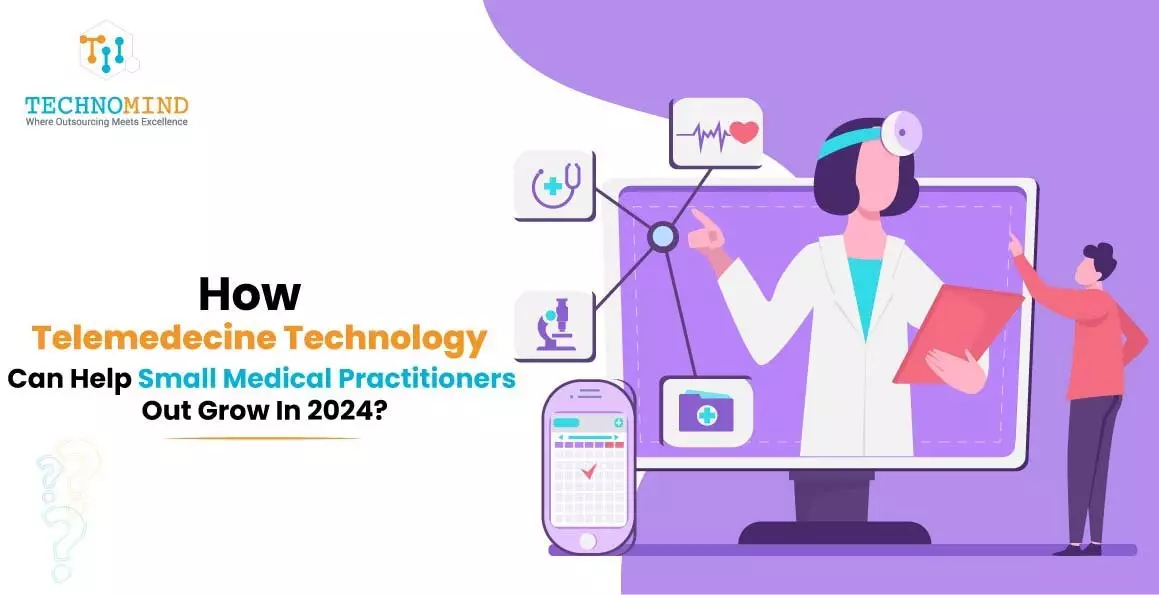Blog
How Telemedicine Technology can help Small Medical Practitioners out grow in 2024?
Everyone wants to grow their business in recent times and without technology it is not possible. That’s an undeniable truth. Big medical giants and hospitals are taking advantage of technologies and digital touch to expand their business but what about local and small individual practitioners?
Small medical practitioners are finding themselves in the dilemma of tradition and innovation. At such a digital savvy time one transformative solution that’s been making their way to grow easy and efficient, is telemedicine.
In this article, we will look at how Telemedicine technology can help small and local medical practitioners in 2024 to outgrow their medical practice and business network.
Telemedicine and Small Medical Practitioners: An Evolving Symbiosis
The evolution of telemedicine has brought forth a transformative era in healthcare, particularly for small medical practitioners.
This partnership signifies a significant shift in how local healthcare providers connect with their communities. Telemedicine breaks down barriers, allowing patients to access care beyond the confines of a physical office. It fosters a more patient-friendly approach, making healthcare more convenient and accessible.
The collaboration between telemedicine and small practices symbolizes a step towards a modern, patient-centered future in healthcare delivery.
Growth and Future of Telemedicine in 2024
In recent years, telemedicine has experienced an unprecedented surge, heralding a new era in healthcare delivery. The growth trajectory of telemedicine is not merely a statistical trend but a paradigm shift that is fundamentally altering how healthcare is accessed and provided.
Unprecedented Surge in Adoption:
The adoption of telemedicine has witnessed an unprecedented surge, fueled by a confluence of technological advancements, changing patient preferences, and global events that underscore the importance of remote healthcare solutions. Small medical practices, in particular, have embraced telemedicine as a means to not only adapt to changing dynamics but also to expand their reach beyond traditional confines.
Technological Advancements Driving Innovation:
Advancements in technology, such as high-speed internet, improved video conferencing tools, and enhanced data security measures, have played a pivotal role in driving the innovation and widespread acceptance of telemedicine. These technological strides are facilitating seamless virtual consultations, remote monitoring, and the exchange of medical information, fostering a more comprehensive approach to patient care.
Changing Patient Dynamics:
The evolution of patient expectations and dynamics has been a catalyst for the growth of telemedicine. Modern patients, accustomed to digital solutions in various aspects of their lives, increasingly seek healthcare options that provide convenience, accessibility, and personalized interactions. Telemedicine aligns with these preferences, offering patients the flexibility to receive quality care from the comfort of their homes.
Global Events and Healthcare Realities:
Recent global events, such as the COVID-19 pandemic, have underscored the critical role of telemedicine in ensuring continued healthcare delivery amid challenges. The pandemic has accelerated the adoption of telemedicine solutions, not only as a response to immediate healthcare needs but as a long-term strategy to build resilient and adaptive healthcare systems.
Regulatory Support and Standardization:
As telemedicine continues to mature, regulatory frameworks are evolving to provide clearer guidelines and support. Standardization in telehealth practices is becoming more pronounced, ensuring a cohesive approach to quality, privacy, and interoperability. This regulatory clarity is expected to foster increased confidence among practitioners and patients alike.
How Telemedicine Apps can Boost the Business of Small and Local Medical Practitioners?
The integration of telemedicine apps has emerged as a transformative catalyst for small and local medical practitioners, offering not only a technological upgrade but a strategic avenue for business growth.
Here’s a detailed understanding of how telemedicine apps can significantly boost the business prospects of small medical practices:
Expanding Reach Beyond Physical Boundaries:
- Utilizes virtual portals to transcend geographical constraints.
- Attracts a broader patient demographic beyond local boundaries.
- Establishes a virtual presence for the practice beyond physical locations.
- Facilitates connections with patients in remote areas or distant communities.
- Offers healthcare services to individuals facing transportation challenges.
Fostering Patient Engagement and Loyalty:
- Enables consistent and personalized virtual consultations.
- Builds trust and loyalty, enhancing overall patient satisfaction.
- Promotes open communication between practitioners and patients.
- Creates a sense of continuity and connection through virtual engagements.
Enhancing Accessibility and Convenience:
- Facilitates remote scheduling of appointments.
- Provides patients with convenient access to healthcare from their homes.
- Improves overall accessibility to medical services.
Optimizing Appointment Scheduling and Workflow:
- Streamlines appointment scheduling processes for efficiency.
- Enhances overall workflow management, reducing wait times.
- Improves the organization of daily operations.
Cost-Effective Practice Management:
- Reduces reliance on physical infrastructure, lowering overhead costs.
- Allows judicious resource allocation for sustainable growth.
- Enhances financial prudence for small medical practices.
Attracting Tech-Savvy Patient Demographics:
- Appeals to a tech-savvy patient population.
- Positions the practice as innovative and forward-thinking.
Marketing and Brand Visibility:
- Leverages the promotion of virtual consultations.
- Enhances brand visibility and attracts local attention.
- Utilizes social media platforms for targeted marketing efforts.
- Participates in community events to increase awareness and engagement.
Ensuring Regulatory Compliance and Data Security:
- Chooses telemedicine apps with regulatory compliance.
- Implements robust data security measures, ensuring trust and credibility.
How Small Medical Practitioners Should Use Telemedicine Technology in 2024?
Customized Telemedicine Apps: Developing a customized telemedicine technology app tailored to the specific needs of the small medical practice is crucial. This ensures that the app aligns seamlessly with the workflows and requirements unique to the practice. Additionally, prioritizing an intuitive and user-friendly interface is essential to enhance accessibility for both practitioners and patients.
Integrated Scheduling and Workflow: Efficient scheduling is at the core of a successful telemedicine practice. Implementing a robust scheduling system within the app streamlines appointment management, reducing administrative burdens. Integrating the telemedicine technology app seamlessly into the daily workflow of the practice ensures that practitioners can easily incorporate virtual consultations into their schedules.
Enhanced Telemedicine Features: To stay competitive and meet evolving healthcare needs, small medical practices should stay updated on emerging telemedicine features. Regularly updating the app to include advanced functionalities, such as AI-driven diagnostics or remote monitoring capabilities, enhances the overall user experience and ensures that the practice remains at the forefront of technological innovation.
Patient Education and Engagement: The telemedicine app serves as more than just a communication tool—it becomes a platform for patient education and engagement. Including features like appointment reminders, secure messaging, and medication tracking fosters continuous patient interaction. Educating patients through the app with relevant resources and information empowers them to actively participate in their healthcare journey.
Telemedicine App Marketing: A well-executed marketing strategy is vital to drive adoption of the telemedicine app within the local community. Leveraging online channels, community outreach, and strategic partnerships enhances the visibility of the app. Clear communication about the benefits and convenience of the telemedicine app encourages both practitioners and patients to embrace this modern healthcare solution.
Training and Support for Practitioners: The successful utilization of a telemedicine app hinges on the proficiency of the practitioners. Providing comprehensive training sessions ensures that practitioners are adept at navigating and using the app effectively. Establishing a dedicated support system for addressing any technical issues promptly reinforces confidence among practitioners, fostering a smooth integration of telemedicine into their practice.
Data Analytics for Performance Improvement: Implementing data analytics tools within the telemedicine technology app offers insights into usage patterns and performance metrics. By leveraging analytics, small medical practices can identify areas for improvement and refine the app’s functionality. This data-driven approach contributes to ongoing enhancements, ensuring the telemedicine technology app remains a valuable asset for the practice.
Conclusion
The integration of telemedicine technology stands as a transformative solution for small medical practitioners. Customized telemedicine apps, efficient scheduling, and enhanced features not only streamline operations but also elevate the patient experience.
If you’re ready to expand your medical practice and looking for developing a telemedicine app tailored to your clinic’s needs, our experts at Technomind Softwares are here to provide unparalleled support.
Contact us today to explore how we can help you harness the full potential of telemedicine and revolutionize the way you deliver healthcare to your patients.
Top Trends in eCommerce and mCommerce for Small Businesses
The year 2023 has witnessed an unprecedented surge in digital transactions, reshaping the way small businesses engage with their customers. According to recent statistics…
How Innovative Technologies Powering Startup Growth in 2024?
Startups are like the cool trendsetters of the digital playground. With their growing usability and importance in business, smart tech, fancy marketing tricks, and social media magic…
How Startups Are Changing Traditional Industries with Technology Adoption?
Who can deny that traditional industries are getting a shake-up from technology startups. These startups, armed with new ideas and high-tech tools…





0 Comments